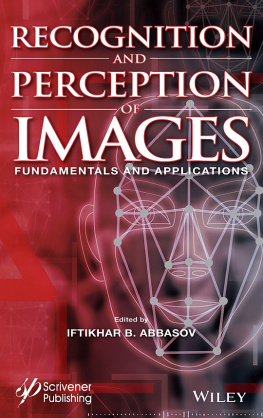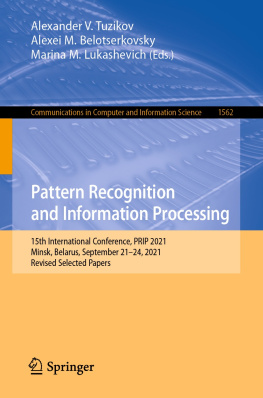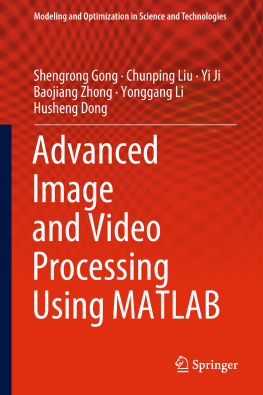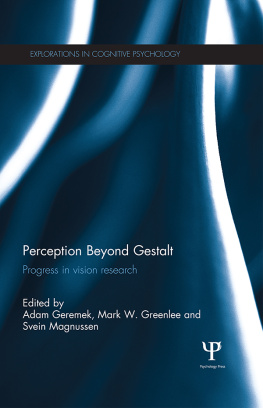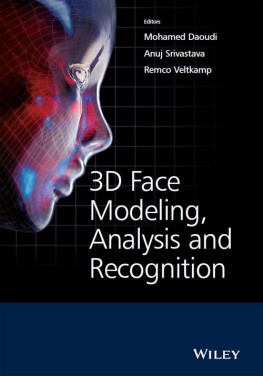
Scrivener Publishing
100 Cummings Center, Suite 541J
Beverly, MA 01915-6106
Publishers at Scrivener
Martin Scrivener ()
Phillip Carmical ()
Recognition and Perception of Images
Fundamentals and Applications
Edited by
Iftikhar B. Abbasov

This edition first published 2021 by John Wiley & Sons, Inc., 111 River Street, Hoboken, NJ 07030, USA and Scrivener Publishing LLC, 100 Cummings Center, Suite 541J, Beverly, MA 01915, USA 2021 Scrivener Publishing LLC
For more information about Scrivener publications please visit www.scrivenerpublishing.com.
All rights reserved. No part of this publication may be reproduced, stored in a retrieval system, or transmitted, in any form or by any means, electronic, mechanical, photocopying, recording, or otherwise, except as permitted by law. Advice on how to obtain permission to reuse material from this title is available at http://www.wiley.com/go/permissions.
Wiley Global Headquarters
111 River Street, Hoboken, NJ 07030, USA
For details of our global editorial offices, customer services, and more information about Wiley products visit us at www.wiley.com.
Limit of Liability/Disclaimer of Warranty
While the publisher and authors have used their best efforts in preparing this work, they make no representations or warranties with respect to the accuracy or completeness of the contents of this work and specifically disclaim all warranties, including without limitation any implied warranties of merchantability or fitness for a particular purpose. No warranty may be created or extended by sales representatives, written sales materials, or promotional statements for this work. The fact that an organization, website, or product is referred to in this work as a citation and/or potential source of further information does not mean that the publisher and authors endorse the information or services the organization, website, or product may provide or recommendations it may make. This work is sold with the understanding that the publisher is not engaged in rendering professional services. The advice and strategies contained herein may not be suitable for your situation. You should consult with a specialist where appropriate. Neither the publisher nor authors shall be liable for any loss of profit or any other commercial damages, including but not limited to special, incidental, consequential, or other damages. Further, readers should be aware that websites listed in this work may have changed or disappeared between when this work was written and when it is read.
Library of Congress Cataloging-in-Publication Data
ISBN 9781119750550
Cover image: Face Recognition (Scharfsinn86 | Dreamstime.com)
Cover design by Kris Hackerott
Set in size of 11pt and Minion Pro by Manila Typesetting Company, Makati, Philippines
Printed in the USA
10 9 8 7 6 5 4 3 2 1
Abstract
This book is dedicated to the unique interdisciplinary research of imagery processing, recognition and perception. The contents of this book are based on the concepts of mathematical processing, compositional analysis applied in art and design, and psychological factors of the information perception process. The conduction of compositional analysis carried out in the course of images processing and recognition, creation of the image project solution and modeling of the conceptual space structures are considered together with the mechanism of their perception. The influence of Internet memes flow on the social networks and face recognition technology subject to interferences are described. The algorithms of perception and improving of accuracy necessary for satellite imagery recognition and complex reflection from the object are represented with the use of artificial neural networks.
The book may be interesting both for engineers and painters. Moreover, it may be useful for students and researchers working in the field of imagery processing, recognition and perception.
Reviewers:
- - Dr. Ratnadeep R. Deshmukh, Professor, Department of Computer Science and Information Technology Dr. Babasaheb Ambedkar Marathwada University, Aurangabad, India
- - Doctor of Phys. and Mathem. Sciences Gennady V. Kupovykh, Professor, Head of the Department of Higher Mathematics, Engineering- Technological Academy of Southern Federal University, Taganrog, Russia
Preface
Visual information is predominant in everyday human life. The use of recognition systems in the different fields of modern civilization subsistence is becoming the order of the day. These systems both ensure social security and make the living environment of the community more comfortable. They became available for each of us, so we no longer look surprised by the faces recognition capability ensured by our smartphones.
The first chapter analyses the issues relating to imagery recognition and conducts a survey of modern tendencies. The peculiarities of images processing and perception are discussed, and the conditional neural processes in brain and psychological manifestations are described.
The issues of compositional analysis carried out in the course of processing and recognition of different purpose images are envisaged in the second chapter. The stages of image composition analysis and detection of differential characteristics on the basis of current methods are represented.
The third chapter is dedicated to the study of perception mechanism and creation of image solution in the course of designer project activities. The color, form and composition as elements of the artistic work are sign-symbolic means of the image-bearing expression.
The fourth chapter deals with issues of associated perception of conceptual space structures. The associative simulation of environmental objects and structures is considered with due regard to perception psychology.
The informative presentation allocation technology necessary for the basic recognition task is studied in the fifth chapter. The face recognition method that is stable regardless of lighting, make-up and masking is represented.
The sixth chapter is dedicated to the development of methodology and software implementation of algorithms for the intellectualized processing of Internet meme flows and detection of their social and political influence in the social network.
The new imagery perception and recognition methods as well as algorithms based on the mathematical approach to the granulating of satellite data are pointed out in the seventh chapter. The algorithms for the large classes of data with the spectral portraits of different signals are introduced.
The methods of reverse radio detection and ranging carried out with the synthesized aperture are described in the eighth chapter. The process of signal generation after the complex reflection from the object is analytically described.
The new method to increase the resolution of multispectral images due to the use of basic spectra is offered in the ninth chapter. The radiometric signals are redistributed in the image subpixels to improve the general physical resolution of the image.
The tenth chapter deals with the theoretical and technological aspects of aerospace imagery processing and interpretation. The peculiarities of aerospace images, methods of their digital representation and interpretation of these images by means of current artificial neural networks are described.
Next page
